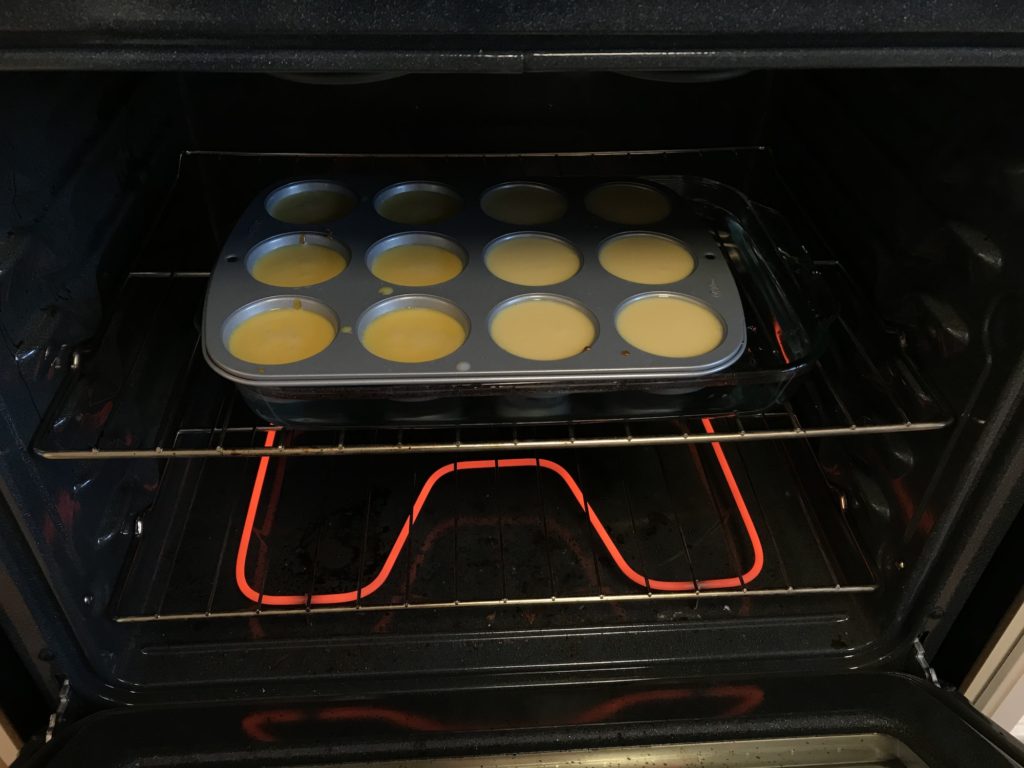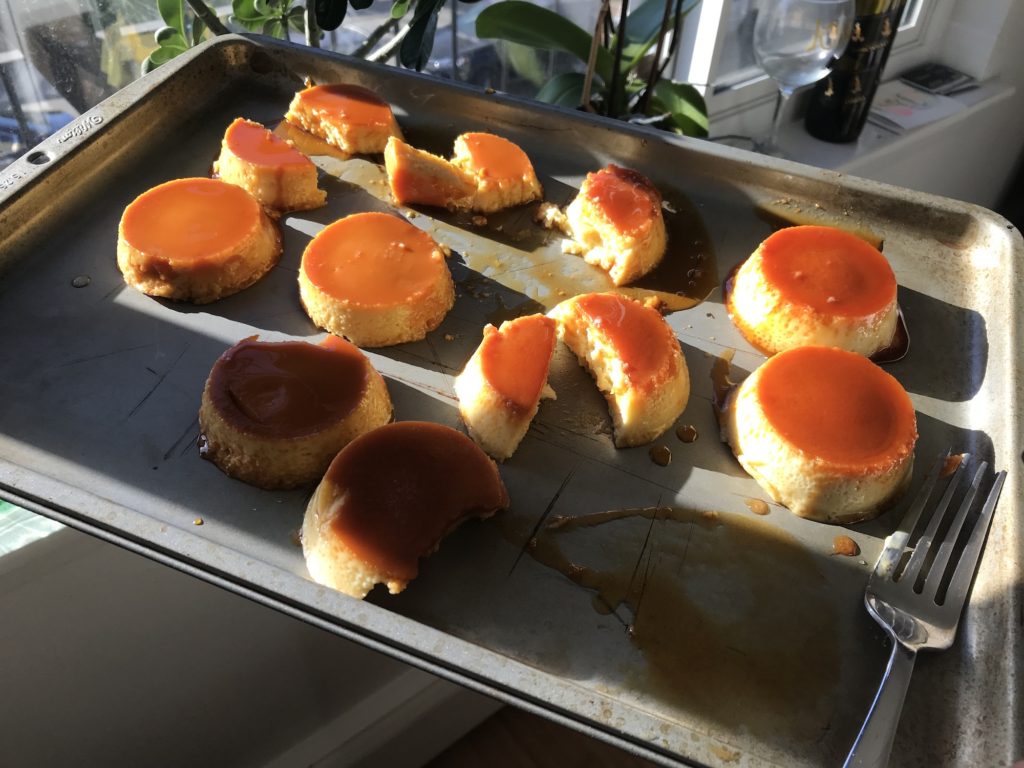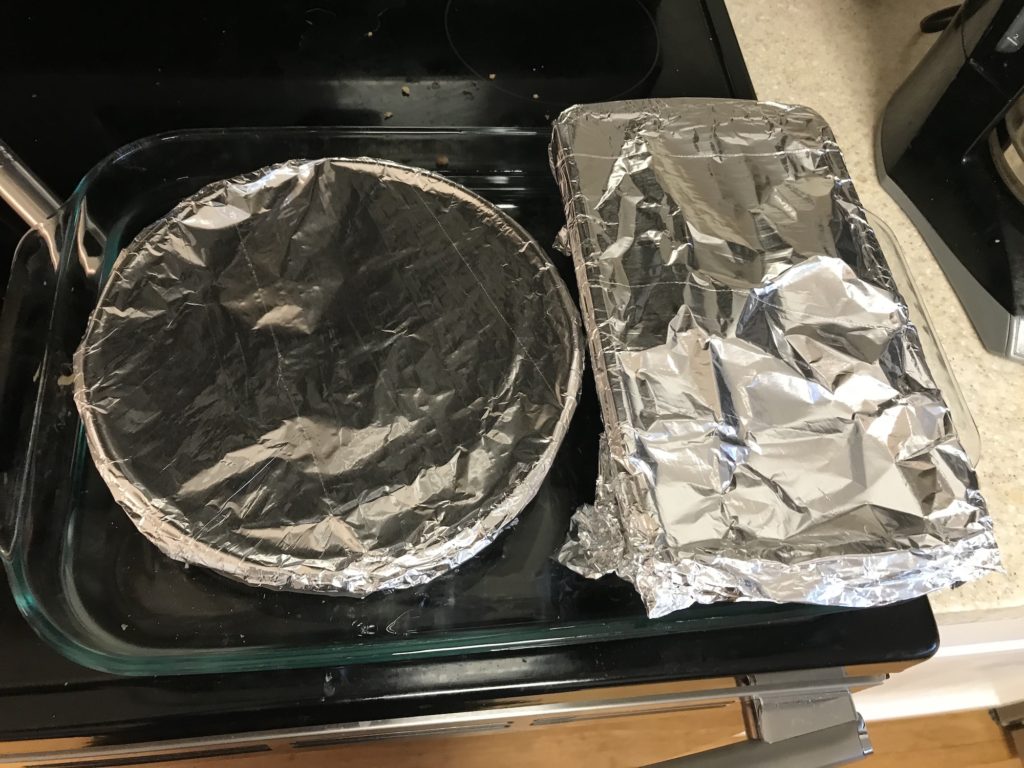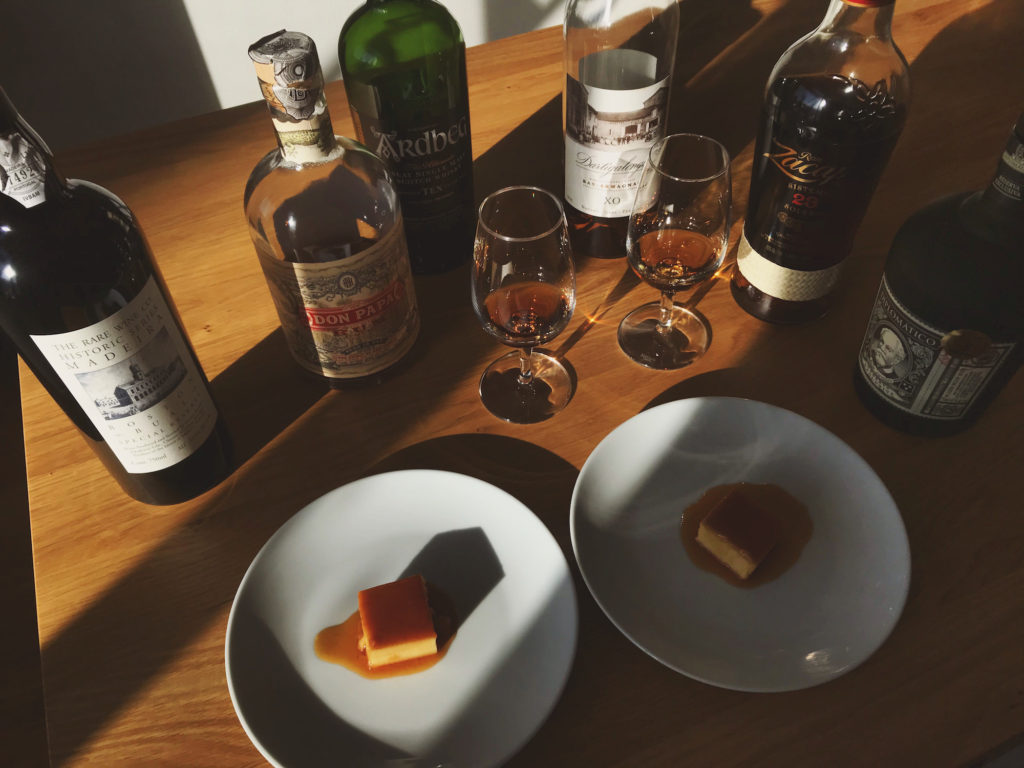I’m tempted to say I’ve never been a huge dessert person, but almost every week in high school involved at least one large bubble tea, my cravings a pendulum swinging between green tea and mango – there may have been a taro phase. Bubble tea in hand along with cheap (and good!) sushi found at what seemed like every block in that Vancouver neighbourhood, and with homework tucked in our backpacks: a past vision of our version of the Central Perk couch from Friends. That one month we became obsessed with High School Musical, which started with a bootleg CD passed among the student body, was a good one.
My dad was always the one known for making and bringing Filipino leche flan to parties, but his version was always a little too rich for me. Leche flan essentially consists of a base made of eggs, condensed milk, and another lighter milk – which, for example, might be evaporated milk or coconut milk – over a layer of caramel that gently bakes in the oven while sitting in a bain-marie. Being an artifact of Spanish influence in the Philippines, flans are also important to many Latin American cuisines. I don’t recall the exact recipe, but my dad’s version also had extra sugar mixed into the base which made it sweeter, and the texture was never too mushy nor too rubbery.
Less saccharine desserts aside, there’s always something that’s bugged me about beverage pairings with sweets. Savoury dishes, to me, are more stretched out in flavour, in a way that a great pairing could add a conversational riposte that you can listen in on with your mouth; desserts seem less like a conversation and more like a tailored pep talk to seal the deal. There’s also the vinous maxim that dictates that the beverage you’d hypothetically pair with dessert should be sweeter than the dessert itself, since anything underneath that threshold would fall flat: but why blast the tongue with more sugar? Most of the time, sweet wines to me are already a dessert.
The sweetness and burst of flavour themselves are almost what you’re there for. I can think of several sweets that might modify flavour without an alcoholic complement, simply because because it’s already in the dessert: think tart raspberry coulid on a rich cheesecake, crushed walnuts on a scoop of chocolate ice cream, or tart powder on Sour Skittles. Subtler desserts are a little easier though. Fruit salad and Moscato d’Asti: I see you.
I think about how leche flan is built, and it reminds me of an Old Fashioned, where a base spirit is modified with both a bitter and a sweet: in this case, a base of egg and milk is modified by the sweetness of sugar and the bitterness of the caramel. How do we elevate this already mouth-coating dish with a libation? I think about it while I work on two different recipes.
All leche flan recipes I look at call for a similar base of caramel in their respective baking tins, and the difference comes in the flan mixture itself. The first recipe I’m looking at involves a base of 5 eggs, 1.5 cups of coconut milk, and a 14oz can of condensed milk; the second recipe – which is closer to that of my dad’s – swaps out 5 eggs for 10 egg yolks, and also swaps out the coconut milk for an 8oz can of evaporated milk. The former recipe has some coconut flavor to fill in some of the blanks, while the latter recipe calls for a teaspoon of vanilla extract – something I also remember my dad using. Both call for a bake at 350°F in a bain-marie for no more than 45 minutes, followed by an overnight chill in the fridge, after which it can be inverted onto your preferred serving plate. Typically, Filipino leche flan is made in an oval-shaped llanera, and is often steamed instead of baked.
I’m mostly interested to see which recipe reigns supreme, and if these differences play into their respective pairings. Also, can we talk about that one time we paired each of the Democratic presidential candidates with a dish or a drink for one of the first 2020 presidential debates, and the local grocery store we called into had the gall to give us a cake when they confirmed over the phone that it was a flan?! Unfortunately, in the case of Elizabeth Warren’s dish: we did not have a flan for that.

Since there are obviously no parties to bring any leche flans to in the middle of this pandemic, I begin with the idea of splitting each of these recipes in half and filling muffin tins for cute individual servings. It works at first, but I have to carefully fit the muffin tin in a glass baking dish which acts as the bain-marie. Unsurprisingly, it’s hard to remove after it’s done baking and half of the muffin tin falls into the water. The salvaged parts were generally overcooked after 40 minutes: they tasted fine, but the texture was a little rubbery.
Sigh. Perhaps the muffin tins were too small. Something something, physics, something? Does a Mulan song play in my head? Maybe. Maybe not.

You’re the saddest bunch I ever met, but you can bet before we’re through. Mister, I’ll make a flan out of you. Alllllright. Onwards.
I look at the egg yolk recipe and see that they recommend covering the flan with foil while it cooks in order to prevent it from overcooking. My dad did this as well, so my gears turn.
I decide to bite the bullet and remake them in full-sized vessels, but removing them at 35 minutes, fully foil-covered, and moved directly into the fridge after they bake. Huzzah: crises seemingly averted, until I flip them the next day. Although the coconut-based flan survived this process a little bit better, they both ended up undercooked, with some sections looking a little more like pudding: edible and tasty, but not flan.
Insert eye twitch here. Do recipe developers not feel completely blue when they end up having to scrap a batch? I know eggs are relatively affordable, but damn. Tossing a failed edible iteration is painful to a person who refuses to eat new things unless the leftovers in the fridge are done. Get it together, Josh. I try to pump myself up by saying I’ve gone through several chemistry lab courses in university, but that hurts rather than helps. I recall the time I wrote “I should’ve gone to H*gwarts” on a chemistry lab final where I seemed to have conjured copper out of thin air.

Third time’s the charm: I repeat the previous recipes, but go for a full 45-minute bake with the foil, also letting the leche flans sit in the water bath after I remove them from the oven: a technique I’ve seen in other recipes. The moment of truth comes the next morning, and it’s nothing but success.
The coconut milk-based flan is much lighter and softer, and the subtle coconut seems to rein back the sweetness. The egg yolk flan is predictably more rich and creamy, leaning into a much more hedonistic expression of leche flan – but it’s still less sweet than my dad’s.
Sigh of relief. Now for a little alcohol?
I know that the sweet Pedro Ximénez Sherry is The One™️ to pair with desserts, and as much as I love it, it’s an echo of my mini-diatribe above: why pair something with your dessert that’s already so much like the sauce that it’s in? It’s like… an echo chamber of sweetness and flavour, or something.

Madeira is the first thing that comes to mind, keeping with the fortified theme, but with more acidity and less obvious saccharinity: of the four quality grapes that make up quality styles, I veer towards Bual or Malmsey – which are made in sweeter styles – instead of the drier styles of Sercial and Verdelho.
Rare Wine Co. “Historic Series – Boston” Bual Madeira Special Reserve (Portugal) Oct 2020. $50 USD.
At first, there’s a streak of something saline or marine, but then it veers towards marzipan, coffee, and dried fruit. The saltiness turns into a mushroom-like rancio aroma reminiscent of aged Cognac or baijiu. The palate is an intense wave of expressiveness, with a slight off-dryness that gets zapped away by this streak of mouthwatering candied and salted lemon peel, which then ends with almond skin.
Long story short: it’s too acidic. It dances with the pairing, but the Madeira sings octaves over the leche flan. Sigh.
I remind myself of the raspberry coulis and cheesecake example from above and grind my gears some more: what if we forwent wine for something a little more committal to match the density, and without overflowing with overt sweetness, like rum or whiskey? I whip out some spirits.
The Ardbeg 10 weirdly works, matching the leche flan‘s fullness with heat, and peaty notes to contrast with the bittersweetness – but the whiskey needs a bit more stuffing in the middle, something along the lines of the richer house style of Lagavulin. The Thomson “Progress Report” Single Malt South Island Peat works slightly better, but I really just wanted to give a shoutout to New Zealand.
Though I have doubts about the flavour profile, I briefly think about how a Filipino rum would be poetic, and I really want it to work. The Don Papa Small Batch Rum, although delicious, has slightly too much of a ripe citrus and candied cola profile to jive with the leche flans. It works, but it’s not perfect. There’s an adjacent story with the Dartigalongue Armagnac XO: it works, but it’s slightly too elegant.
My winners are the Diplomático Reserva Exclusiva Rum from Venezuela and the Ron Zacapa Centenario 23 Sistema Solera Rum from Guatemala. Brandied cherry notes are brought out in the former, adding a present sprinkle of sweetness and flavour without overwhelming the flan, while the latter brings about a slight earthiness to anchor down the sweetness and contrast with the flavours while adding a slight nutty tone.
I call this a success. An OnlyFlans success, if you will.
I still hate wine pairings for Halloween candy though.
Diplomático Reserva Exclusiva Rum (Venezuela) Oct 2020. $35 USD.
Vanilla, brandied cherries, and caramel, with hints to tropical fruit and cola. A pinch of sweetness on the palate with an extraverted echo of oak and cherry, but with a slight wave of nuttiness and toffee at the end.
Zacapa Centenario 23 Sistema Solera Rum (Guatemala) Oct 2020. $55 USD.
Less confronting with its sweetness, with a base of subtle earthiness overlaid with nuts, dried fruit, and wisps of smoke. Dry, balanced, and finessed, with savoury notes of sultana, oak spice, and sherry.